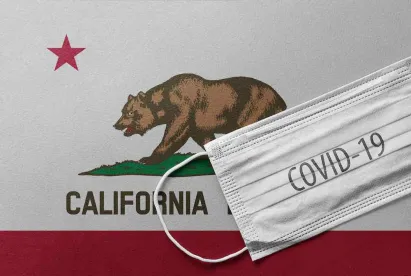California retailers facing a variety of complications from the ongoing COVID-19 pandemic now have one additional obstacle to tackle: compliance with new emergency standards from California’s Division of Occupational Safety and Health (“Cal/OSHA”). On November 19, 2020, the California Occupational Safety and Health Standards Board unanimously adopted emergency temporary standards on COVID-19 prevention in the workplace. Prior to the adoption of the emergency standards, general and industry-specific guidance from Cal/OSHA was advisory. However, the new emergency standards are binding and enforceable against nearly all California employers effective November 30, 2020. This article sets forth the basic requirements under the new standards. It then identifies some new complications and costs that retail employers in particular may face when attempting to comply.
Applicability of COVID-19 Emergency Standards
The emergency standards apply to most employers with California-based employees. The new standards do not apply to employees when covered by Cal/OSHA’s Aerosol Transmissible Diseases standard, which applies to work at certain healthcare facilities, laboratories and a limited number of other employers. Additionally, the new standards do not cover employees who work from home or employers with only one employee if the employee has no contact with others. Thus, the new standards presumably cover all retail operations in California.
COVID-19 Prevention Program
The main requirement of the emergency standards is that employers must prepare, implement, and maintain a written COVID-19 Prevention Program (“CPP”). The CPP appears to be modeled on the written Injury and Illness Prevention Plan (IIPP) that Cal/OSHA regulations require all California employers to implement and maintain. In fact, the standards state that the CPP either may be integrated as part of an employer’s IIPP or maintained in a separate, standalone document.
According to Cal/OSHA, the CPP must provide for the following:
-
System for communicating information to employees about COVID-19 prevention procedures, testing, symptoms and illnesses, including a system for employees to report exposures without fear of retaliation.
-
Identification and evaluation of hazards – screening employees for symptoms, identifying workplace conditions and practices that could result in potential exposure.
-
Investigating and responding to cases in the workplace – responding immediately to potential exposures by following steps to determine who may have been exposed, providing notice within one business day about potential exposures (similar to the requirements under AB 685), and offering testing to workers who may have been exposed.
-
Correcting COVID-19 hazards – including correcting unsafe conditions and work practices as well as providing effective training and instruction.
-
Physical distancing – implementing procedures to ensure workers stay at least six feet apart from other people if possible.
-
Face coverings – providing face coverings and ensuring they are worn.
-
Adopting site-specific strategies such as changes to the workplace and work schedules and providing personal protective equipment to reduce exposure to the virus.
-
Positive COVID-19 case and illness recording requirements and making the CPP accessible to employees and employee representatives.
-
Removal of COVID-19 exposed workers and COVID-19 positive workers from the workplace with measures to protect pay and benefits.
-
Criteria for employees to return to work after recovering from COVID-19.
-
Requirements for testing and notifying public health departments of workplace outbreaks (three or more cases in a workplace in a 14-day period) and major outbreaks (20 or more cases within a 30-day period).
-
Specific requirements for infection prevention in employer-provided housing and transportation to and from work.
The bullet points above provide a very cursory summary. The standard is very detailed with numerous, onerous requirements. Cal/OSHA did not publish its FAQ guidance and a model written COVID-19 Prevention Program until the day after the emergency standards went into effect. Thus, while retail employers may have already implemented a COVID-19 response plan based on retail-specific guidance from Cal/OSHA, many requirements likely change or expand significantly the policies or procedures that employers originally implemented and listed in their response plans previously. Additionally, the model CPP prepared by Cal/OSHA instructs that employers should identify and describe in the CPP the specific policies and procedures that satisfy the requirements.
CPP Requirements that Create Retail-Specific Complications
The following requirements in particular are likely to create new complications and costs for many retail employers.
-
Hazard Assessment: Employers must conduct a workplace-specific identification of all interactions, areas, activities, processes, equipment, and materials that could potentially expose employees to COVID-19 hazards. When performing the assessment, employers must treat all persons, including customers, as potentially infectious, and comply with specific requirements in the emergency standards. Because the assessment must be workplace-specific, retailers with multiple store locations in California should make sure they perform and document a hazard assessment for each location. Additionally, the assessments should be re-evaluated during the investigation for any positive test or outbreak.
-
Optional Testing for Close Contacts: Employers must offer COVID-19 testing at no cost to employees, during their working hours, to all employees who had close contact with an infected individual in the workplace. In connection with this requirement, employers must inform all employees on how they can obtain testing, either through the employer, local health department, a health plan, or at a community testing center. Because the hours and days when testing is available may vary by testing location, this information will vary for each retail location and should take into account where employees reside as well.
-
Exclusion Pay: The most surprising of the new requirements in the emergency standards is that employers must continue to provide an excluded employee’s pay and benefits if the employee is able and available to work and the COVID-19 exposure is work-related. The standards require employers to exclude from the workplace any employees with a confirmed case until they satisfy certain return-to-work criteria and any employees who with COVID-19 exposure until they complete the required 14-day quarantine period. Cal/OSHA’s guidance states that employers may require the employee to exhaust paid sick leave benefits before providing exclusion pay, and may offset payments by the amount an employee receives in other benefit payments. However, the guidance does not address how much pay is owed to part-time employees with variable hour schedules. Additionally, there is no limit on the amount of exclusion pay that must be provided, meaning an employee could receive exclusion pay multiple times.
-
Required Testing During an Outbreak: Among the protocols that an employer must implement in the event there is an “outbreak” (i.e., three or more confirmed cases in a workplace in a 14-day period), the most costly is clearly the requirement to provide testing to all employees in the exposed workplace during the 14-day outbreak period. Initial testing must occur immediately, repeat one week later and continue on a weekly basis until the exposed workplace no longer qualifies as an outbreak. Cal/OSHA’s guidance clarifies that an “exposed workplace” is a work location, working area, or common area used or accessed by an infected individual (including customers) during the high-risk period, including bathrooms, walkways, hallways, aisles, break or eating areas, and waiting areas. The guidance further clarifies that when determining which areas constitute a single “exposed workplace” for purposes of enforcing testing requirements, Cal/OSHA does not expect employers to treat areas where masked workers momentarily pass through the same space without interacting or congregating as an “exposed workplace.” Nevertheless, most retail locations likely only offer one breakroom or set of restrooms. Thus, this new requirement may effectively require testing for every employee in the entire store who worked during the 14-day outbreak period. Moreover, if there is a “major outbreak” (i.e., 20 or more confirmed cases in the exposure workplace within a 30-day period), required testing for all employees in the exposed workplace must occur at least twice weekly. In sum, the costs for testing during an outbreak can be significant.
Takeaway
In addition to the above, the most difficult component of the new emergency standards is likely the requirement that employers comply immediately. Although Cal/OSHA’s guidance claims that enforcement personnel will consider an employer’s good faith efforts in working towards compliance, the guidance also identifies certain requirements, such as eliminating hazards and implementing testing requirements during an outbreak, that are “essential.” For employers experiencing an outbreak who find themselves now required to roll out testing immediately during work hours, compliance will be especially challenging. Employers with any questions or concerns on the new emergency standards should consult with experienced employment counsel to ensure they are compliant.
As you are aware, things are changing quickly and there is a lack of clear-cut authority or bright line rules on implementation. This article is not intended to be an unequivocal, one-size fits all guidance, but instead represents our interpretation of where things currently and generally stand. This article does not address the potential impacts of the numerous other local, state and federal orders that have been issued in response to the COVID-19 pandemic, including, without limitation, potential liability should an employee become ill, requirements regarding family leave, sick pay and other issues.




 />i
/>i

